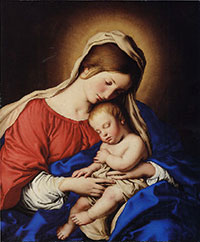 August is not only dedicated to the Immaculate Heart of Mary, but also to the Solemnity of the Assumption and the Queenship of the Blessed Virgin Mary. That means this month is an opportune time to reflect on music composed to honor Our Lady.
August is not only dedicated to the Immaculate Heart of Mary, but also to the Solemnity of the Assumption and the Queenship of the Blessed Virgin Mary. That means this month is an opportune time to reflect on music composed to honor Our Lady.
One of the most timeless examples came from the Renaissance composer Josquin des Prez (c. 1450-1521). His “Ave Maria … virgo serena” remains one of the most popular and stunning works in music history. It falls under the genre of sacred motet, a vocal piece that at the time of Josquin’s writing was characterized by all the voices singing the same words to allow for text clarity, an issue of great importance during that time.
Although we often view composers in the past as revered geniuses, they were regular people and, in Josquin’s case, had a playful sense of humor. As David W. Barber recounts in his “Bach, Beethoven, and the Boys,” Josquin was promised a raise that never materialized. To hasten the process in a rather clever manner, he composed the motet “Remember thy word unto thy servant.” The message was received, and after getting his raise, Josquin penned a piece on the text “Lord, thou hast dealt graciously with thy servant.”
The full title of “Ave Maria … virgo serena,” is generally used to distinguish it from other Ave Marias by the same composer. This one is sometimes referred to as the
“Mona Lisa of Renaissance music” and, like its Da Vinci counterpart, is incredibly well-known and instantly recognizable. Although the work cannot be dated with certainty, it is believed to have been composed in the 1480s.
As was typical of the time, the text is in Latin. Josquin opens the work with a quotation of a Gregorian chant on the words first acclaimed by the angel Gabriel: “Hail Mary, full of grace, the Lord is with you (serene Virgin).” The voices present this joyful acclamation imitatively which, while beautiful, makes it difficult to understand the text. But the words are recognizable to any Catholic. After the opening, the imitation changes to enhance textual clarity as each of the subsequent five stanzas sings of the major Marian feasts: Conception, Nativity, Annunciation, Purification (now referred to as the Presentation), and the Assumption.
The work begins and ends in duple meter – which today may seem insignificant, but prior to the Ars Nova (“New Art”), a concept of 14th-century France that allowed for duple meter, triple meter was used almost exclusively because of its symbolism of the Holy Trinity. (In fact, units of three in music notation were called “perfections.”) Thus, when Josquin places one verse into triple, it is of great importance. The text in this stanza translates to “Hail true virginity, immaculate chastity whose purification was our purgation,” which demonstrates the critical role the Blessed Mother plays in our Salvation. Additionally, all four voices are sounding simultaneously to draw emphasis on these essential words. (When you watch the video at the link below, this begins at 2:30 in the clip.)
Josquin precedes the ending section of the work with a measure of rest to grab the attention of the listener (occurring at approximately 4:00 in the online clip). Some interpret these words as a final, personal plea by the composer, and 500 years later, are ones that we still benefit from praying: “O Mater Dei, memento mei” (“O Mother of God, remember me”).
— Christina L. Reitz, Special to the Catholic News Herald. Christina L. REITZ, Ph.D., is a professor of music at Western Carolina University in Cullowhee. (Photo courtesy of Western Carolina University.)


